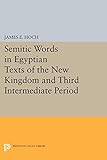Semitic Words in Egyptian Texts of the New Kingdom and Third Intermediate Period / James E. Hoch.
Material type: TextSeries: Princeton Legacy Library ; 284Publisher: Princeton, NJ : Princeton University Press, [2014]Copyright date: ©1994Edition: Course BookDescription: 1 online resource (596 p.)Content type:
TextSeries: Princeton Legacy Library ; 284Publisher: Princeton, NJ : Princeton University Press, [2014]Copyright date: ©1994Edition: Course BookDescription: 1 online resource (596 p.)Content type: - 9780691602554
- 9781400863884
- 493/.1 23
- online - DeGruyter
- Issued also in print.
| Item type | Current library | Call number | URL | Status | Notes | Barcode | |
|---|---|---|---|---|---|---|---|
 eBook
eBook
|
Biblioteca "Angelicum" Pont. Univ. S.Tommaso d'Aquino Nuvola online | online - DeGruyter (Browse shelf(Opens below)) | Online access | Not for loan (Accesso limitato) | Accesso per gli utenti autorizzati / Access for authorized users | (dgr)9781400863884 |
Frontmatter -- CONTENTS -- ACKNOWLEDGEMENTS -- LIST OF TABLES -- ABBREVIATIONS AND SIGLA -- INTRODUCTION -- PART I: The Semitic Words -- 1-101 -- 102-201 -- 202-300 -- 301-401 -- 402-500 -- 501-595 -- PART II. ANALYSES AND CONCLUSIONS -- 1. Phonology -- 2. Morphology -- 3. Domain of Use -- 4. The Genres of Texts -- 5. The Source Languages -- 6. The Development of Group Writing -- APPENDIX: CATALOGUE OF SIGNS -- BIBLIOGRAPHY -- INDEXES
restricted access online access with authorization star
http://purl.org/coar/access_right/c_16ec
Semitic words and names appear in unprecedented numbers in texts of the New Kingdom, the period when the Egyptian empire extended into Syria-Palestine. In his book, James Hoch provides a comprehensive account of these words--their likely origins, their contexts, and their implications for the study of Egyptian and Semitic linguistics and Late-Bronze and Iron-Age culture in the eastern Mediterranean. Unlike previous word catalogs, this work consists of concise word studies and contains a wealth of linguistic, lexical, and cultural information.Hoch considers some five hundred Semitic words found in Egyptian texts from about 1500 to 650 b.c.e. Building on previous scholarship, he proposes new etymologies and translations and discusses phonological, morphological, and semantic factors that figure in the use of these words. The Egyptian evidence is essential to an understanding of the phonology of Northwest Semitic, and Hoch presents a major reconstruction of the phonemic systems. Of equal importance is his account of the particular semantic use of Semitic vocabulary, in contexts sometimes quite different from those of the Hebrew scriptures and Ugaritic myths and legends. With its new critical assessment of many hotly debated issues of Semitic and Egyptian philology, this book will be consulted for its lexical and linguistic conclusions and will serve as the basis for future work in both fields.Originally published in 1994.The Princeton Legacy Library uses the latest print-on-demand technology to again make available previously out-of-print books from the distinguished backlist of Princeton University Press. These editions preserve the original texts of these important books while presenting them in durable paperback and hardcover editions. The goal of the Princeton Legacy Library is to vastly increase access to the rich scholarly heritage found in the thousands of books published by Princeton University Press since its founding in 1905.
Issued also in print.
Mode of access: Internet via World Wide Web.
In English.
Description based on online resource; title from PDF title page (publisher's Web site, viewed 30. Aug 2021)


